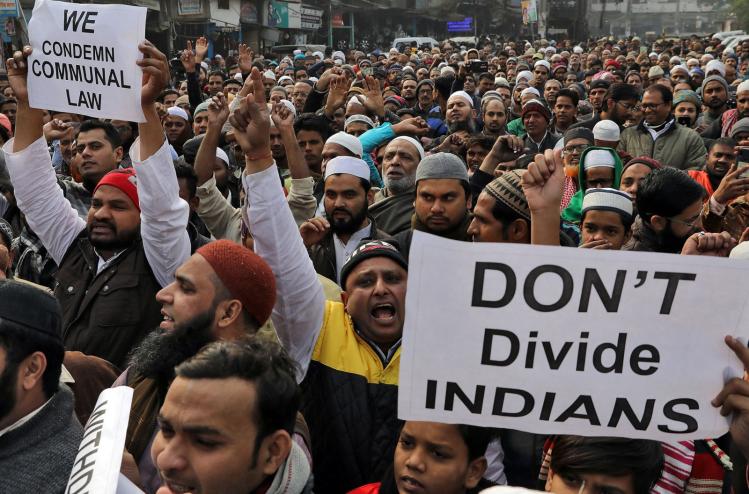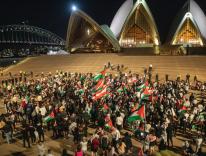
It is difficult to describe India these days. I start to write each morning and by evening everything has changed. In the years I have lived here, only once have I seen anything like what is happening now. That was in 1990 during the first flood of protests against India’s version of affirmative action. In those days, as a young mother with children to bring up, and without phone or television, I was not paying such close attention. Yet even I was aware that feelings were running incredibly high. Schools were closed for months; courts shut down; transport was disrupted. For three unforgettable days, a curfew was imposed in our city and in many others. (A curfew sounds harmless when it’s happening somewhere else. If it’s happening in your own town, it feels sinister.)
These days most Indians are more politically aware. Even the poorest families have TV, and almost everyone has a cell phone. WhatsApp and Twitter are powerful organizing tools: crowds can be summoned in a matter of minutes. But that alone does not explain the scale of the protests against the government’s recent Citizenship Amendment Act (CAA), which makes Hindu, Buddhist, Jain, and Sikh immigrants from Bangladesh, Afghanistan, and Pakistan eligible for citizenship, but excludes Muslims. The new social-media platforms have helped channel the anger, but they don’t explain the feeling of fear and dread so many Indians now wake up with every morning. Many people here are beginning to realize that, with the rise of Hindutva (Hindu nationalism), the basis of India’s democracy is in jeopardy. The country’s constitution, for which so many gave their lives, is being violated by its government. Indians are incredibly patriotic citizens. Here in the world’s largest democracy, the Freedom Struggle is still a living memory for millions. And the average person—like my own husband—feels personally responsible for what their parents and grandparents fought and died for.
Most Indians want to trust their leaders. It is natural for people who have ousted a foreign power to assume that a government of their own can be believed. But in August the crackdown in Kashmir, India’s only Muslim-majority state, set warning bells ringing more widely than ever. Today, nearly five months later, restrictions on daily life in Kashmir are still in force. Phone service is curtailed, internet access almost nonexistent. Schools have been closed since the crackdown began and people are largely confined to their homes.
I recently met two Kashmiris who appeared to have been traumatized by the events in their region. They were nervous, disoriented. Both social workers, they spoke in low voices about the confusion, frustration, and depression many Kashmiris are experiencing. They spoke of people with chronic illnesses who can’t buy the medicines they need, of the anxiety of not knowing how relatives are faring. They described shops empty of all but the most basic supplies. The Indian media reports that all is now well in Kashmir: everything is normal and daily routines have resumed. No internet and no phones, true, but that’s just for the people’s own safety.
Meanwhile, the rest of the country has been encouraged for some years now to be wary of Muslims in general. Their loyalties have been questioned in various public forums, as well as in private channels. Many of my friends report having to leave family WhatsApp groups because of the anti-Islamic hatred expressed there. A Muslim colleague’s son developed school phobia after being bullied and isolated because of his religion.
India’s prime minister, Narendra Modi, has repeatedly suggested that Muslims are behind the violence that has sometimes erupted during mass demonstrations against his government’s new citizenship law. “You will know them by their clothing,” he says. Old tropes about Muslims breeding like rabbits in order to take over the country are repeated at rallies and on social media. In fact, the percentage of India’s population that is Muslim has remained almost exactly the same for the past seventy years. Christians are sometimes also mentioned by the Hindu nationalists, but only half-heartedly. Muslims are the real enemy.
Amit Shah, India’s Home Minister, has described illegal Muslim migrants from Bangladesh as “infiltrators” and said they are “like termites in the soil of Bengal.” In defense of the CAA, Shah now assures the public that “no citizen of India need worry about anything.” Since neither Shah nor Modi has ever publicly denounced the lynchings, mob violence, and other targeted attacks against India’s Muslim citizens, people here don’t find this reassuring.
The real question is why the country suddenly needs a new registry of citizens. India already has a robust census, conducted every ten years, as well as a massive Aadhaar (identity) initiative that has registered all residents by name, address, and biometric details. There are also voter IDs and PAN (Permanent Account Number) cards for anyone who comes under the Indian Income Tax Department.
The new registry will be expensive and time-consuming. The 2011 census cost approximately $1.2 billion and involved 2.5 million “enumerators”—all government workers (teachers, primarily) who stop doing their regular jobs until they finish the count. With preparations for the 2021 census already underway, people are asking what justifies yet another such exercise. The fear is that the turn to a formal registry is a clear signal that data collected elsewhere will now be used to determine who counts as a “true” Indian according to Hindutva ideology.
Hence the unprecedented opposition to the CAA, which was passed by India’s parliament in December. Spontaneous and massive demonstrations have swept the entire country. These gatherings are remarkable not only for the extent to which they have caught the authorities off guard but also for the wide range of people attending them. It’s not just students or the urban elite who keep showing up. Village women’s groups, unions, fisher-folk, and farmers are also out in force, outnumbering the educated elite, speaking eloquently and authoritatively to huge groups in the streets.
Muslims are of course the people most deeply worried about the CAA, because they are its main targets, but poor people in general have good reason to be anxious. While government officials insist that no citizen has any reason to fear, poor people frequently do not have the documents required to prove their identity. Simply having a government-issued identity card is not enough. The act also requires proof of parents’ and sometimes grandparents’ citizenship, but previous generations frequently had no written records of anything. A long paper trail of identifying documents is still largely a middle-class luxury.
For many who live in the northeastern state of Assam, the nightmare has already begun. Assam borders Bangladesh and has a long history immigration from that country, so the national government has been testing its citizens registry there since 2015. In the first round of registration, 8 million people were left off the rolls. Recounting reduced that number to 1.9 million, mostly Bengali Muslims.
The new registry is a recipe for a humanitarian crisis. Detention camps have already been constructed (and more are planned) to house those awaiting deportation, yet there appears to be no plan either for what the detained will do while they’re living in these camps or for where to deport them. Bangladesh, which is already dealing with thousands of displaced Rohingya Muslims from Myanmar, has said it will not accept refugees from India, and it’s unlikely that any other country will volunteer to take them in.
Like other major initiatives of Modi’s Bharatiya Janata Party (BJP)—for example, its demonetization policy—this one has been rammed through without much regard for the consequences. There is already a worldwide refugee crisis of staggering proportions: in 2015, the number of displaced persons was over 61 million according to the UN Refugee Agency. If India succeeds in deporting even 10 percent of its 200 million Muslims, most of whom were born and raised in this country, the global implications will be massive.
Some observers here say that the CAA is a distraction technique, designed to keep people from paying attention to flagging economic growth, massive unemployment, and steadily worsening indicators in health, education, and the environment. In general, the quality of life in India is poor. Deemed the most dangerous country in the world for women in a 2018 Thomson Reuters Foundation survey, India also has the distinction of being home to twenty-two of the thirty most polluted cities in the world. Thirty-eight percent of Indian children are stunted because of malnutrition. Yet, despite all these problems, the BJP government somehow has the time and energy to worry about who worships where, who’s wearing what, and who eats what kind of meat. Like all bullies, this government is insecure about its own abilities and eager to shift the blame for its own failings onto a scapegoat.
Fortunately, most Indians know a bully when they see one. Because voters are more concerned with a living wage and good public services than with who prays to whom, the BJP is no longer calling all the shots here. Elections in the states of Jharkhand and Maharashtra in December delivered decisive blows to the ruling party, and it’s likely there will be more blows from other states in the next year. Many Hindus say they will register as Muslims if the CAA is enforced, while many Muslims have decided not to register at all. Ten states have announced that they simply will not implement the Citizens’ Amendment Act.
Meanwhile, several people have already given their lives in this battle for India’s constitution, including teenagers shot by police during riots in some of the country’s most impoverished areas. While India celebrates the strength and tenacity of its democracy, it is still the young and the poor who suffer the most to keep real democracy from being hollowed out by bigots and opportunistic politicians.
Please email comments to [email protected] and join the conversation on our Facebook page.
Previous Story
Strange Gods
Next Story
Theological Drift

